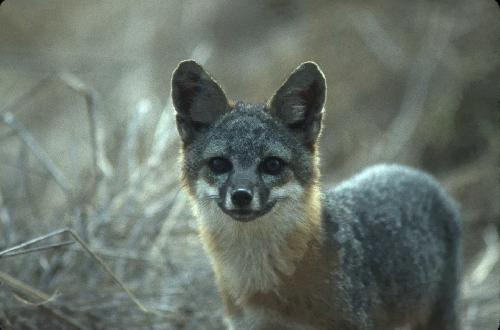In comparison to their relatives on the mainland, the Channel Island foxes living on six of California's Channel Islands are dwarves, at two-thirds the size. The island foxes most likely evolved from gray foxes brought to the northern islands by humans over 7,000 years ago. Some think island foxes may have been partially domesticated by Native Americans. Like many island species, they have little fear of humans.
Now a new study reported in the Cell Press journal Current Biology on April 21 finds that the foxes also show a surprising absence of genetic variation. The study offers the first complete genome sequences of an island species that is a model for long-term conservation of small, endangered populations, the researchers say.
"We find a dramatic reduction of genetic variation, far lower than most other animal species," says Jacqueline Robinson of the University of California, Los Angeles (UCLA).
 This is a photo of a Channel Island fox. Credit: Dr. Gary Roemer (groemer@nmsu.edu)
This is a photo of a Channel Island fox. Credit: Dr. Gary Roemer (groemer@nmsu.edu)
One population in particular living on San Nicolas Island has an order of magnitude lower variation than any other known species, including the severely endangered African cheetah, Mountain gorilla, and Tasmanian devil, she says. Such near absence of genetic variation doesn't bode well for the foxes. But it also presents a puzzle as to how the foxes have managed as well as they have.
"The degree to which the San Nicolas foxes have lost genetic variation is remarkable, upholding a previous observation that they may be the least genetically variable population of wild animals known," says Robert Wayne, also of UCLA. "It suggests that under some conditions, genetic variation is not absolutely essential for the persistence of endangered populations."
The researchers sequenced DNA samples representing each of the Channel Island fox populations and one mainland gray fox from southern California. Researchers originally collected the island fox samples back in 1988, prior to subsequent population declines due to predation and disease in four of the island populations
Theory holds that small populations will not only lose variation, but will also accumulate deleterious variation as the normal process of natural selection fails. Indeed, the complete genomes of the island foxes show dramatic, 3- to 84-fold declines in heterozygosity. (Heterozygosity refers to places in the genome where an individual has inherited different variants of the same gene from their mother and father.) The foxes also show sharp increases in genes for which they carried two copies of a variant deemed to be harmful or deleterious in some way.
The San Nicolas Island population of foxes has a near absence of variation, the researchers report, demonstrating a unique "genetic flatlining." The only variation found in those foxes occurs at "heterozygosity hotspots," enriched for olfactory receptor genes and other genes with high levels of ancestral variation.
The researchers say the new findings need to be taken into careful consideration in plans for the foxes' future, including the removal of their federal endangered species protection status.
"The island fox populations suffer from both a lack of genetic diversity and the accumulation of damaging genetic variants, which is likely to worsen over time," Wayne says. Island foxes are also susceptible to population crashes from disease and non-native predators, such as golden eagles.
Additional research is needed to understand how the foxes may compensate for their decreased variation and the accumulation of deleterious variants. Wayne and Robinson say they'd like to explore gene expression and regulation in the foxes, to find out whether these factors may act to alleviate some of the effects of deleterious variants.
source: Cell Press